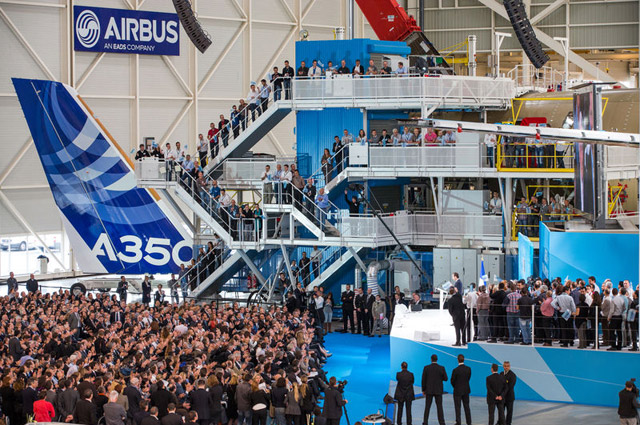Airbus has resolved the issues with the automated drilling process used to produce wings for the in-development A350 at its Broughton, UK factory.
The problems, caused by systems that were not properly optimised, had seen the airframer revert to manual drilling on the first two shipsets.
But Didier Everard, A350 programme manager, says those glitches are now behind it and the automated process has recommenced.
The wings for aircraft MSN3 are "almost finished" at Broughton and wing production is back at its target rate, he said at an event in Toulouse to mark the inauguration of the A350 final assembly line.
 |
|---|
Airbus |
Everard remains confident that the first flight of the twinjet - to be performed by fight test aircraft MSN1 - will take place in mid-2013, but he concedes problems could occur that would delay the maiden sortie.
Five aircraft will participate in the flight test campaign. Three will fly without cabins installed, while MSN2 and MSN5 will be used to test the interior systems.
Rolls-Royce has begun production of the first Trent XWB engines for the flight test aircraft, having already built 10 development powerplants, says Everard.
One of these has been in use on the airframer's A380 flying testbed where it has accumulated 144h in the air and a further 208h in ground tests.
Concerns had been raised by customers of the largest variant, the -1000, that it was overweight and underpowered. Everard says R-R has identified the modifications required to reach the increased 97,000lb thrust mandated by Airbus. This will be achieved through "technology insertion" to allow higher temperatures in the hot section and a larger core.
Although customer concerns remain, some have been mollified. Steven Udvar-Hazy, chairman of lessor ALC, says: "That's still to be seen as far as the weight of the aircraft is concerned. But in the briefings over the last 24 hours it's clear they understand the concerns and are addressing those issues and if necessary Rolls-Royce will have make sure there's a little extra power.
"They understand what the issues are and where they have to be and are on top of things, particularly in terms of weight control."
Airbus is placing most emphasis on the -900 and -1000 variants of the A350, amid continuing weakness in the backlog for the -800, the smallest aircraft in the family.
Although Airbus envisages the -800 being the second model produced, due to enter service in mid-2016, Everard says there is still flexibility in its schedule to advance the -1000 from its entry-into-service date of mid-2017 if required. "The sequence may change depending on the market if there is increasing demand for the -900 and -1000."
However, he says there is no risk of its cancellation "for the time being".
The A350-900 is due to enter service in mid-2014 with launch customer Qatar Airways.
Source: Air Transport Intelligence news
















